
* The Navy and Marines were happy with the Hornet, though it did have certain limitations, particularly with regards to range and combat load limits. The imminent obsolescence of other Navy aircraft with longer range and greater load capability led the Navy to initiate development of a scaled-up Hornet, which would emerge as the "F/A-18E/F Super Hornet". The original Hornet had its critics, but the criticisms drawn by the Super Hornet were downright scathing. Once again, however, it went into service, like it or not, and the Navy also obtained an electronic warfare variant of the Super Hornet, the "EA-18G Growler".
* During the 1980s, the US Reagan Administration engaged in a massive defense buildup, with funding provided for a wide range of weapon systems. A joke made the rounds that US Defense Secretary Caspar Weinberger "never saw a weapons system he didn't like." At the time, US Navy air power was based on the F-4 Phantom, A-7 SLUF, and A-6 Intruder, all of which were in the twilight of their operational lives; the newer F-14 Tomcat interceptor; and the very new F/A-18 Hornet fighter. Aircraft wear out -- or become too obsolescent to survive in combat against more modern opponents and defenses, even if they don't -- and need to be replaced.
The Navy had a number of programs in the pipeline for replacements, including a much improved "A-6F" Intruder and an "F-14D" Tomcat, as well as an advanced stealthy carrier-based strike aircraft, the McDonnell Douglas / General Dynamics "A-12" triangle flying wing, nicknamed the "flying dorito". There was also interest in developing an improved version of the Hornet to address some of the type's limitations.
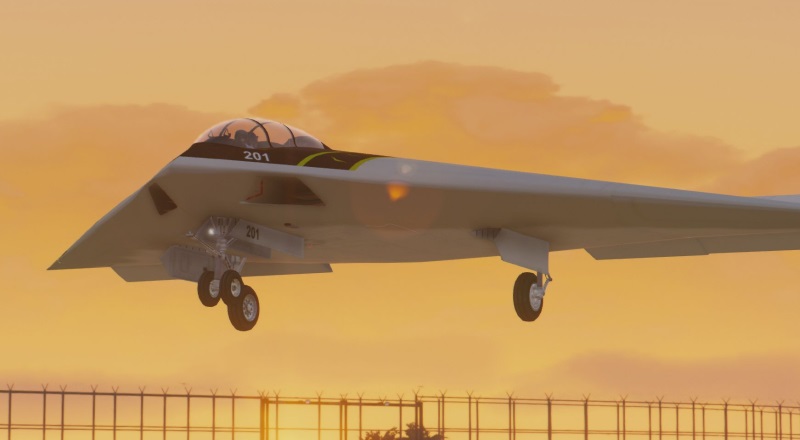
Navy brass who believed that funding for such a large set of major programs could be sustained over the long run were living in a fool's paradise, and gradually programs began to get the axe. When push came to shove, the A-12 program had to be selected over the A-6F, and so the advanced Intruder variant was canned. Unfortunately, this ended up being a "double whammy": when the secret A-12 effort was finally revealed to the public, the program's problems also came to light. The A-12 was behind schedule and over budget, and it got the axe in early 1991, just before the beginning of Operation DESERT STORM, the effort to oust the Iraqis from Kuwait. Although the Navy participated in the air war, due to a combination of factors, including a lack of a leading-edge strike capability, the Navy embarrassingly only performed a little more than a fifth of the number of sorties of the Air Force. It was an intolerable loss of face for Navy brass.
The Navy was still planning to obtain an advanced attack aircraft, the "AX", but the AX wasn't to reach service until 2020. Something less ambitious was needed in the interim. The alternatives were a multi-role version of the F-14D and the concepts being promoted for an improved Hornet -- referred to here generally as the "Hornet 2" for convenience, although there were a number of different names, such as "Hornet 2000". The Hornet 2 faction, which significantly included US Defense Secretary Dick Cheney, felt that they had the cheaper option, with the lower cost allowing the Navy to obtain enough fighters to keep their carrier air wings in operation until the AX arrived. A new long-range AAM, the "AIM-155", would permit the Hornet 2 to do the Tomcat's fleet air defense job.
The most direct thing to do was conduct a "fly-off" between the two proposals -- but then politics intervened in the form of a scandal at the "Tailhook" convention of naval aviators in September 1991. There was a drunken bash that resulted in several female participants complaining that they had been mistreated; in the howling public scandal that followed a number of top Navy brass were accused of covering up the matter, leading to a series of resignations.
The Tailhook scandal was a messy issue, and discussion of its details in a document on an aircraft is neither relevant nor interesting. What is relevant was that the scandal threw the Navy command structure into confusion at a time when some important decisions had to be made. One of the significant consequences was that Navy Secretary Lawrence Garrett resigned, to be replaced by Sean O'Keefe, who was close to Cheney and in the Hornet 2 camp. The result was that the Hornet 2 faction won out, with the Navy committing to the development of the machine without a competitive fly-off.
A contract was awarded to McDonnell Douglas in June 1992 for seven Hornet 2 engineering and manufacturing development (EMD) machines. That was a major decision, and events quickly made it a completely irreversible one as well. The incoming Clinton Administration was focused on defense cuts, a not unreasonable attitude given the end of the Cold War -- though as it would turn out, peace hadn't quite broken out all over by any means. In any case, the AX, which had evolved by that time into the joint-service "A/F-X" project, was canned.
To be sure, defense programs have an odd way of rising from the dead, and the A/F-X concept would re-emerge as the F-35 Joint Strike Fighter. Navy brass didn't know that would happen at the time. If they wanted to have aircraft to fly off their carriers, there was only one game left in town -- the Hornet 2.
Two variants were planned: a single-seater, the "F/A-18E", and a two-seater, the "F/A-18F". The F/A-18E/F was seen as a true multi-role aircraft, replacing the F-14 Tomcat and the F/A-18A/C in the air superiority, strike, and reconnaissance roles; the Lockheed S-3B Viking in the tanker role; and (as it would turn out) the EA-6B Prowler in the electronic warfare mode. In another irony of the situation, the AIM-155 long-range AAM was also given the axe, so the F/A-18E/F would have to rely on the AIM-120 AMRAAM for fleet defense. AMRAAM was certainly more modern than the big Phoenix AAMs used by the Tomcat, but AMRAAM's range was significantly shorter. In any case, the first EMD machine, a single-seater, was rolled out in Saint Louis on 19 September 1995. The new aircraft was unimaginatively but inevitably named the "Super Hornet".
BACK_TO_TOP* What the Navy wanted most of all from the Super Hornet was a parameter called "bring-back weight". The original F/A-18A/B/C/D Hornet -- called the "legacy Hornet" these days -- was overweight and could not land on a carrier carrying much more than AAMs and empty drop tanks. If it was carrying bombs or other air-to-ground munitions, it had to discard them before landing.
That hadn't been such a problem in the past, because in the 1980s the Navy still mostly relied on iron bombs, cluster munitions, and unguided rocket pods. Combat doctrine in those times usually assumed that such munitions could be dumped on a secondary target if the primary couldn't be hit, and since such munitions were inaccurate to begin with, they were dropped even if target visibility wasn't the best, in hopes of inflicting some damage anyway. If worst came to worst and they had to be discarded, they weren't too expensive, with iron bombs described as being "as cheap as hamburger" on a weight basis.
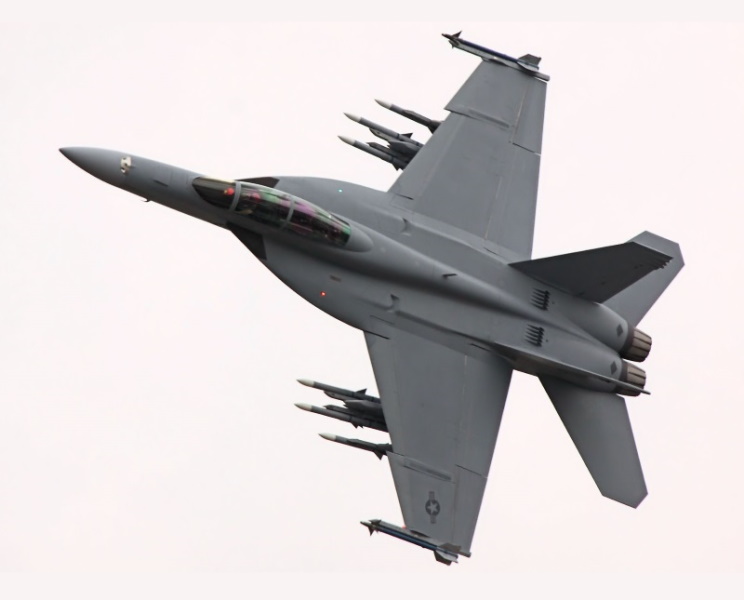
However, by the end of the 1980s, precision-guided "smart munitions" had begun to predominate. The lethal accuracy of smart munitions meant one relatively expensive munition could be used to destroy a target, instead of several cheap iron bombs. Smart weapons also greatly reduced the risk of "collateral damage" to unintended civilian targets; with the rise of the "dirty little conflicts" in the 1990s, collateral damage became increasingly unacceptable, further reinforcing the usefulness of smart munitions.
Smart munitions were more expensive than iron bombs and couldn't be discarded so easily. Furthermore, the heightened concerns over collateral damage meant that such munitions weren't going to be dropped if there was a serious chance of them going astray, or if there were uncertainties about the legitimacy of a target. In sum, that meant that an aircraft was likely to often come back to a carrier with unexpended munitions that cost too much to just dump. An improved Hornet simply had to have a greater bring-back weight.
Increasing the bring-back weight meant giving the Hornet a larger wing. Since the legacy Hornet had suffered from wing flexing problems, the wing thickness had to be increased. The bigger wing meant more drag, so the sweepback was increased; and it also meant reduced maneuverability, so the LERX were redesigned. Ironically, the configuration of the LERX went back to something like that of the original Northrop Cobra concepts. The Super Hornet could have been nicknamed the "Super Cobra" -- except that the Marines already had that name for their improved Bell AH-1 helicopter gunships.
* The legacy Hornet's lack of range was of course another high-priority issue, and so the fuselage was stretched to provide more internal fuel capacity. More internal space was reserved for future avionics growth, with provisions made for greater electrical power to drive avionics systems. All the increases meant more weight, with the Super Hornet eventually having an empty weight 25% greater than that of the legacy Hornet. In another irony of the Super Hornet saga, an aircraft that had started out as the YF-17 lightweight fighter ended up only slightly smaller than an F-15 Eagle heavy fighter.
The greater weight demanded more engine power. GE came up with a new engine, the "F414", based on the F412 engine developed for the canceled A-12, with the F414 providing 35% more power than the old F404s. The Super Hornet's engine inlets were changed from the D-shape of the legacy Hornet to a distinctive rectangular wedge shape that provided more airflow.
In addition, there had been improvements in stealth technology since the introduction of the legacy Hornet, and there was no reason not to take advantage of them. The geometry of the engine inlets was tweaked and more RAM was fitted; a baffle was developed by GE that was fitted in front of the F414 engines to eliminate reflections from the engine fan; and some airframe changes were made to eliminate radar traps.
However, a stealthy Super Hornet carrying ordinary external stores would still be highly visible to radar, and there were those who questioned that the efforts put into stealth were worth the bother. The reply was that there was never really any intention to make the Super Hornet a true "stealth fighter"; it was just that reducing the signature of the aircraft made its active countermeasures systems that much more effective.
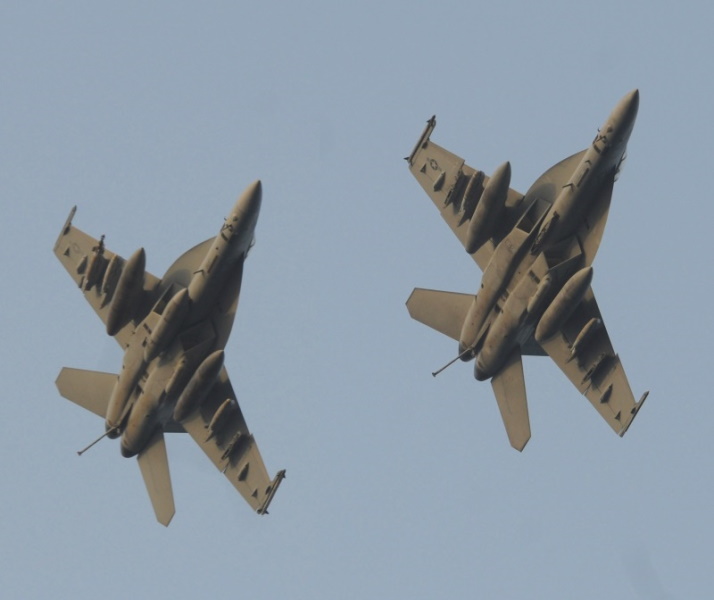
With all the changes the Super Hornet was basically a new aircraft, not a simple upgrade of the legacy Hornet -- and in fact, it only really retained the forward fuselage of the legacy Hornet's airframe. That was probably not a surprise to everyone, since it often happens when an aircraft update involves substantial changes such as new engines and major airframe changes. However, what was a bigger surprise was that the Super Hornet didn't meet its performance specifications, being distinctly inferior in speed, acceleration, and agility to late-build legacy Hornets.
A legacy Hornet pilot who took on the Super Hornet in air combat exercises was quoted as saying: "We outran them, we out-flew them, and we ran them out of gas. I felt embarrassed for these pilots." It is hard to know how seriously to take such a remark, since combat pilots tend to have big egos and talk big accordingly -- and there were plenty of Super Hornet-bashers determined to leave "no stone left unthrown".
___________________________________________________________________
BOEING F/A-18E SUPER HORNET:
___________________________________________________________________
wingspan with AAMs:
13.68 meters (44 feet 10 inches)
wingspan (folded):
9.94 meters (32 feet 7 inches)
wing area:
46.45 sq_meters (500 sq_feet)
length:
18.38 meters (60 feet 4 inches)
height:
4.88 meters (16 feet)
empty weight:
14,550 kilograms (32,080 pounds)
MTO weight (catapult):
29,940 kilograms (66,000 pounds)
max speed at altitude:
1,955 KPH (1,215 MPH / 1,055 KT)
service ceiling:
15,250 meters (50,000 feet)
ferry range:
3,075 kilometers (1,660 MI / 1,088 NMI)
combat radius:
1,750 kilometers (1,085 MI / 945 NMI)
___________________________________________________________________
* One way or another, the Navy had committed to the Super Hornet, and no alternatives were available. The Super Hornet passed its operational evaluation (OPEVAL) in early 2000, with the Navy then awarding Boeing a contract for 222 machines, to be delivered from 2002 through 2006. US Navy VFA-115, the first squadron of "Super Bugs" as the type was nicknamed, performed its first deployment in the summer of 2002 on board the USS ABRAHAM LINCOLN. By the end of 2003, a total of 170 Super Hornets had been delivered, equipping five squadrons. Further buys would follow.
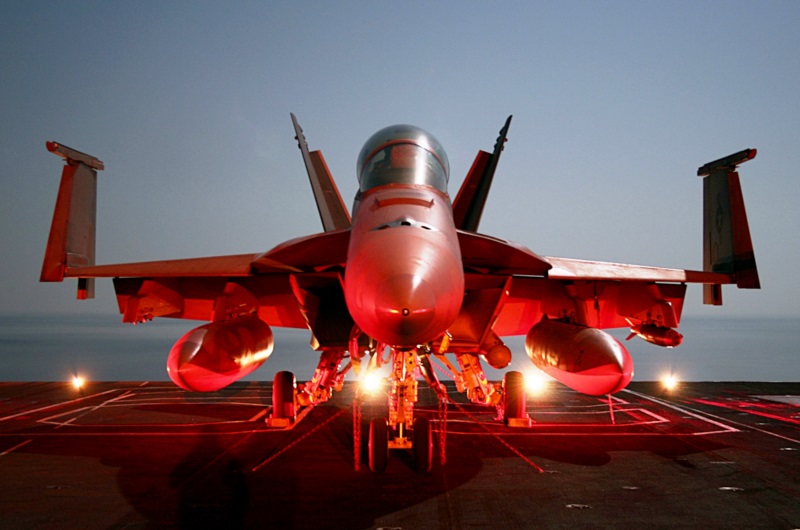
The deficiencies of the Super Hornet have been mentioned, but of course the Navy got major benefits as well. The Super Hornet had 40% more range than the legacy Hornet, could carry a much larger warload, and could return to the carrier with unexpended weapons. It was a clear step up from the legacy Hornet in terms of manufacturing sophistication, with 42% fewer parts. It featured a substantial proportion of carbon-fiber assemblies, replacing metal assemblies of the legacy Hornet.
The avionics suite was originally about the same as that of late-configuration F/A-18C/Ds, with the AN/APG-73 radar, and generally similar cockpit layout and avionics systems. The critics seized on the Super Hornet's avionics as "antiquated" because they were the same as the legacy Hornet's, but as discussed earlier, a legacy Hornet with modern upgrades is by no means behind the times. In addition, at least initially (and to no great surprise), the Super Hornet was not qualified for all the new stores that were planned for it. The SLAM-ER cruise missile was a significant omission, and the Super Hornets could not drop LGBs, though the Navy had other assets to perform those roles until the Super Hornet got up to speed.
The Super Hornet was also supposed to provide the reconnaissance capability that had been repeatedly fumbled on the legacy Hornet, but the "Shared Reconnaissance Pod (SHARP)" was not available initially. SHARP was a fully-digital reconnaissance system with electro-optical and infrared sensors for medium and high altitude reconnaissance, with a slant range of 83 kilometers (52 miles). It featured a datalink for realtime relay of intelligence data. Raytheon developed the pod, which was derived from a 1,250-liter (330 US gallon) centerline external fuel tank. It allowed the Super Hornet to replace the F-14 carrying the TARPS film reconnaissance pod.
The faltering of the development program for the Integrated Defensive Electronic Countermeasures (IDECM) system meant that initial production Super Hornets were fitted with less sophisticated AN/ALQ-165 Advanced Self-Protection Jammer (ASPJ) and the AN/ALE-50 towed decoy.
* Weapons qualifications went ahead, and enough Super Hornets were available by the spring of 2003 to allow the type to make a major contribution to the invasion of Iraq, with F/A-18Es of VFA-115 from the USS ABRAHAM LINCOLN dropping hundreds of tonnes of bombs. Super Hornets often flew sorties with four 900-kilogram (2,000-pound) Joint Direct Attack Munition (JDAM) GPS-guided bombs.
Two F/A-18Fs were ferried from the USS NIMITZ to join the operation, flying as "fast FACs". They used the JHMCS sight to spot targets and obtain coordinates, which were then relayed back to a strike platform. Two developmental SHARP pods were put into service as well, and the Super Hornet also flew large numbers of tanker sorties. The Navy learned to appreciate the value of the Super Hornet as a tanker, because it could carry up to five external tanks, giving it a heavy fuel load; could match the performance of the aircraft it refueled; and could take care of itself if attacked, eliminating the need for an escort. There was no real air opposition to the invasion, and the Iraqis did not shoot down any Super Bugs.
BACK_TO_TOP* The initial production Super Hornet was an interim configuration, with improvements to be added in production as they became available. Following initial production, several refinements were introduced, including:
These improvements were a stepping stone to the "Block II" Super Hornet, introduced in 2005. The primary features of the Block II were the Raytheon AN/APG-79 active electronically scanned array radar system, plus a new rear cockpit layout, the "Advanced Crew Station (ACS)". The new avionics required enhanced power and cooling systems, as well as a fiber-optic data bus.
The AN/APG-79 was derived from technology developed by Boeing and Raytheon for the F-35 program. The radar had an antenna that consisted of a matrix of programmable transmit-receive (T/R) modules, which could act cooperatively or individually, allowing the system to act as a "low probability of intercept" radar; a precision jammer; or an electronic intelligence system to locate and target emitters. Functions could be, in principle, performed simultaneously by allocating blocks of T/R modules to each function; the AN/APG-79 was "multi-mode" in a very strong sense, being able to track an aerial target while mapping out ground targets. Astonishingly, the high degree of parallelism allowed the front-seater and the back-seater to effectively each have their own radar.
Even ignoring its ability to perform operations in parallel, the AN/APG-79 was much more capable than the AN/APG-73 that it replaced; it had three times greater detection range and incorporated a high-resolution synthetic aperture radar (SAR) mode that had five times the resolution of the AN/APG-73, allowing the Block II Super Hornet to take over the maritime targeting job from the S-3 Viking. The AN/APG-79 has received software, and it appears some hardware, upgrades to make it more effective. As mentioned earlier a downsized derivative, the AN/APG-79(V)4, was developed for retrofit to the F/A-18C/D, with Marine and Canadian legacy Hornets to be upgraded to this radar.
The Block II had a completely new forward fuselage, partly to support the new systems. However, the new fuselage also reduced the parts count by 40% to improve manufacturability and maintainability, and provided better service access. The new forward fuselage was actually introduced into production in 2003; all Super Hornets with the new forward fuselage were capable of being refitted with the AN/APG-79 AESA, and an upgrade program for the older machines began in 2008.
Most of the Block II Super Hornets obtained by the US Navy were two-seaters, reflecting the service doctrine for "net-centric" warfare, in which weapons platforms were "nodes" in a network where volumes of tactical data are transferred back and forth. In net-centric warfare, two crew were needed because the back-seater had to track the network activity; make the appropriate decisions based on that data; and control the aircraft's systems accordingly, while the front-seater actually flew the aircraft. That made the back-seater more a peer to the front-seater than ever before -- and in fact, in the Block II Super Hornet, the back-seater could actually perform weapons release.
Boeing leased the very first F/A-18F back from the Navy to perform experiments to demonstrate the utility of the Super Hornet in the net-centric combat environment -- for example, collecting video data from a SHARP pod and transferring it to an airborne command post, as well as a FAC on the ground. The Navy retrained F-14 back-seaters, traditionally known as "radar intercept officers (RIO)", to become Block II Super Hornet "weapon systems officers (WSO)", a term more traditionally associated with the Air Force.
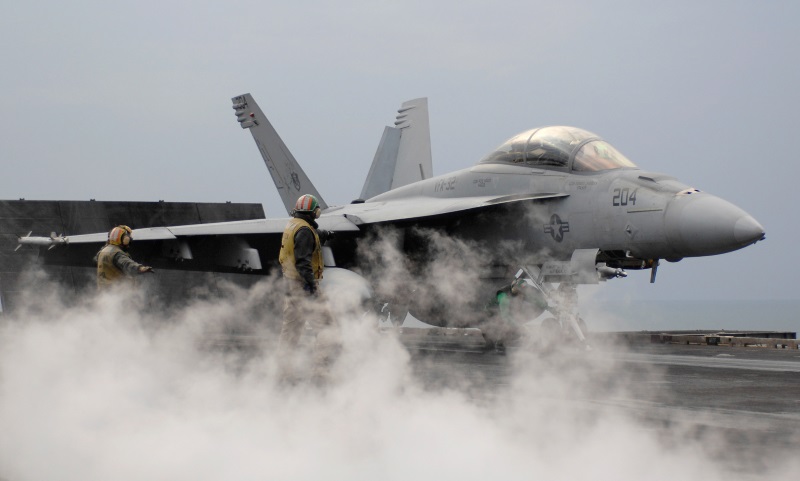
* The Block II Super Hornet also featured an improved defensive countermeasures system, based on the Raytheon AN/ALR-67(V)3 RWR and the BAE Systems / ITT AN/ALQ-214(V)3 Integrated Defensive Electronic Counter-Measures system. IDECM integrated an ITT signals receiver; a BAE Systems onboard jamming techniques generator; and the AN/ALE-55 fiber-optic towed decoy (FOTD). The FOTD was trailed behind the aircraft on a fiber-optic cable to broadcasts jamming or deception signals produced by the techniques generator. This meant that if a missile had a "home on jam" mode, it would attack the FOTD and not the aircraft. Refined blocks of the IDECM have been introduced on an ongoing basis.
Along with the improved avionics, the Block II Super Hornet was qualified to carry new weapons. The longer range and greater capability of the AN/APG-79 AESA implied a longer range and more capable AAM, and the result was the "AIM-120C-7" variant of the AMRAAM. The AIM-12OC-7, also known as the "Pre-Planned Product Improvement (P3I) Phase 3" AMRAAM, featured a smarter seeker and an improved flight control system that stretched its range. The AIM-120C-7 was followed by the "AIM-120D" in 2007, with a 50% increase in range, a two-way datalink, improved navigation system, and greater maneuverability. With the AIM-120D, the Block II Super Hornet could provide long-range air defense for US Navy carrier groups, taking up the slack left by the retirement of the Tomcat.
The Block II Super Hornet could carry the Raytheon AIM-9X Sidewinder as well. This version of the venerable Sidewinder family not only provided off-boresight targeting, with its seeker cued by the pilot's JHMCS sight, and extreme agility, it was even capable of a degree of "beyond visual range (BVR)" engagement. Aircraft sensors allowed it to obtain a lock at ranges in excess of 22 kilometers (12 NMI); Raytheon developed a "Block II" with a datalink and a "lock on after launch (LOAL)" mode that allowed the missile to engage targets at the very limits of range, or even behind the launch aircraft.
In addition, to enhance the Super Hornet's ship-killing capability, the service qualified the Lockheed Martin Long-Range Antiship Missile (LRASM) with the F/A-18E/F. LRASM is a stealthy weapon with a range of about 930 kilometers (580 miles), and was designed as a replacement for the venerable Harpoon antiship missile. LRASM was introduced to service in 2019.
Other improvements added to Block II machines in the course of production, and retrofitted to earlier machines, included:
The IRST, also known as the "IRST21", developed by Lockheed Martin and produced by Boeing, was derived from an IRST used on the Grumman F-14 Tomcat. The Super Hornet's IRST was mounted on the front of the centerline fuel tank, meaning no changes to the airframe -- though there were adaptations of aircraft systems, notably to provide "sensor fusion" with radar and other inputs.
Yet another improvement was an "Automatic Ground-Collision Avoidance System (Auto-GCAS)", which prevented a pilot from flying the aircraft into the ground. This was "merely" a software update to the flight control system. Auto-GCAS also ended up in the US Marine and Canadian legacy Hornet upgrades -- though not with the same implementation, since the legacy Hornet didn't have an electronic throttle.
* From 2014, Super Bugs participated in strikes on Islamic State insurgents in Iraq and Syria. On 18 June 2017, a Super Hornet support Syrian opposition forces near the town of Ja'Din shot down a Syrian government Sukhoi Su-22 strike fighter, which had attacked the opposition forces and refused to be warned off. It was the first air-to-air kill of the Super Hornet, the third kill of the Hornet family, and the first US kill since 1999. The incident led to hot talk between the US and Russia, which backed the Syrian government.
The last Block II machines were delivered in the spring of 2020, for total production of 608 Block I & II Super Hornets, including 322 single-seaters and 286 two-seaters.
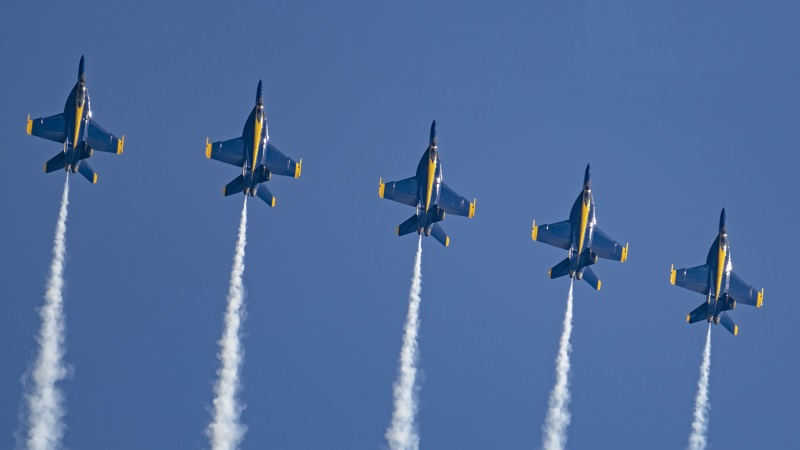
The Blue Angels have transitioned to the Super Bug, Boeing having been awarded a contract in 2016 to investigate modification of Super Hornets for the flight demonstration role -- which involved stripping out the cannon and some other combat systems, adding smoke generators, and performing a few other tweaks. The decision was made to convert nine single-seaters and two two-seaters to the demonstrator configuration, with the work to be completed in 2021. The conversions were done by a Navy field modification team.
BACK_TO_TOP* The Navy's Grumman EA-6B Prowler electronics countermeasures (ECM) platform provided excellent service for decades, but by the year 2000 its days were clearly numbered. The Navy estimated that the Prowler force would fall below minimum strength by 2006, meaning that acquisition of a replacement was urgent.
The F/A-18E/F Super Hornet was judged the best candidate for a replacement; the aircraft was in production and could be adapted to the standoff jamming mission with relatively little effort. Since the Navy was standardizing on the Super Hornet as its basic combat aircraft, a Super Hornet ECM platform had the advantage of being compatible with other Navy aircraft in terms of much of its logistics and its ability to operate with a strike package.
In late 2002, the Navy formally committed to development of an ECM version of the two-seat F/A-18F, designated the "EA-18G Growler". The Growlers were to be built on the same production line as the Block II F/A-18E/F -- which was upgraded to an "F-Plus" configuration to make the airframes of both variants compatible. The F-Plus airframe imposed a slight weight penalty.
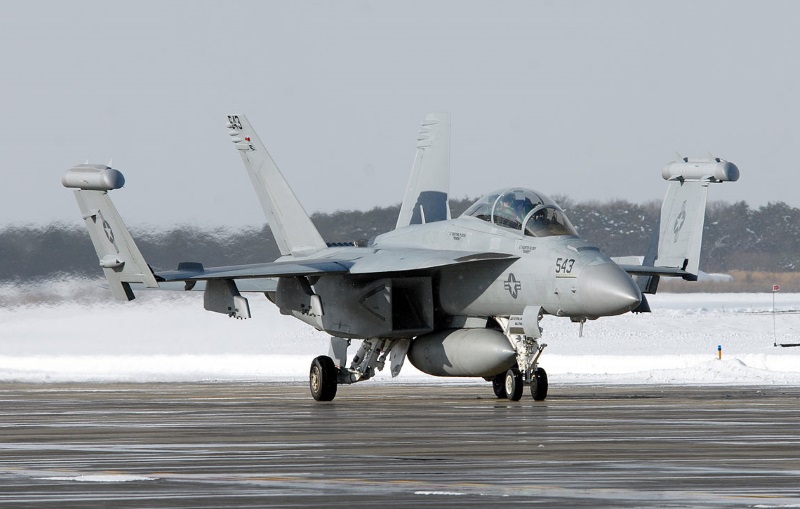
The EA-18G was based on the "ICAP-3" upgraded countermeasures system developed for the Prowler. Each of the Super Hornet's engines incorporated an electrical power generator, allowing the aircraft to drive internal ECM systems. The Growler's kit included:
The EA-18G was also fitted with the AN/APG-79 AESA radar, which was gradually integrated with the rest of the Growler's countermeasures systems. A typical operational configuration would consist of three AN/ALQ-99 jammer pods, two external tanks, two HARMs, and two AMRAAMs. The Growler emerged as a state-of-the-art jamming platform, capable of simultaneous action against a wide range of radar and communications systems. Boeing had to design a special "Interference Cancellation System" to prevent the aircraft from jamming its own UHF radio system.
The two-seat F/A-18F was used as the basis for the EA-18G because the workload required a dedicated electronics warfare officer (EWO or "raven"), riding in the back seat. Since the Prowler seated three EWOs, the Growler was designed with enhanced automation to reduce workload. The front-seater could also operate countermeasures systems to balance the workload when needed.
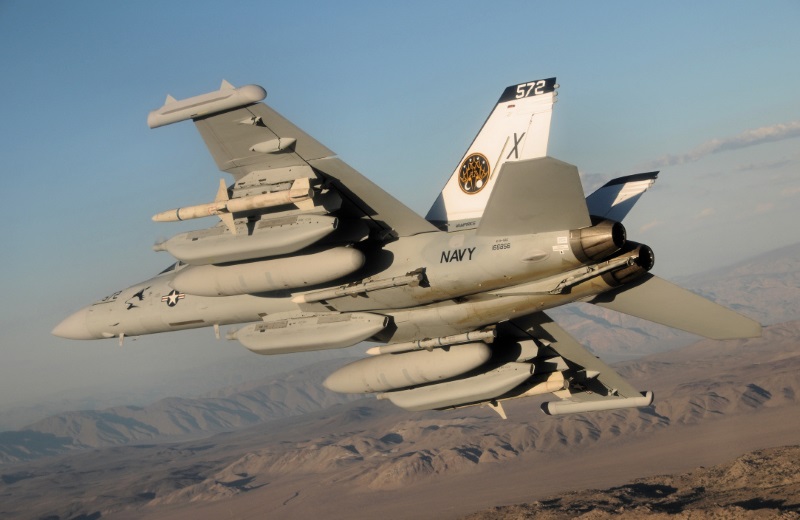
An F/A-18F configured as an initial EA-18G prototype performed its first flight in that configuration in November 2003. The first true prototype performed its initial flight in the summer of 2006. The first production Growler was delivered to the Navy in the spring of 2008, with the type reaching initial operational capability in September 2009 and initial operational deployment in early 2011. The first operational use of the EA-18G was in support of the NATO intervention in the Libyan revolution in 2011. The Navy was pleased that one EWO really could do the job in a combat scenario.
The Navy obtained one squadron of five Growlers on each of the Navy's carriers, along with a land-based component for inter-service support -- the US Air Force no longer having an equivalent. That led to a total acquisition of 160 Growlers, not counted in the Super Hornet acquisitions. The last Growler was delivered in the summer of 2020. There are currently no plans to build any more, but some attrition replacements likely will be needed.
Boeing has pushed the EA-18G for export sales -- as well as in a "Growler Lite" configuration, the main "detuning" being deletion of the AN/ALQ-99 from the operational kit. Of course, the Growler will also inherit new functionality being developed for the F/A-18E/F, as part of a projected "Block II" Growler upgrade effort.
One of the core upgrades for the Block II Growler is the AN/ALQ-249 "Next-Generation Jammer / Mid-Band (NGJ/MB)" jammer pod, which will replace the elderly AN/ALQ-99 pod. The AN/ALQ-99 leaves something to be desired in terms of reliability and sd it is also somewhat "draggy", and interferes with the Growler's AESA radar.
The AN/ALQ-249 has an AESA system, capable of agile and sophisticated electronic attacks against multiple hostile "emitters" simultaneously. It has greater range, and is relatively easily upgraded through its modular open systems architecture. TQ-249, like the AN/ALQ-99, has a spinner for generating power, but the AN/ALQ-249's is not fixed to the nose, instead being hidden behind doors when not in use, reducing drag. The modular design will support future low-band and high-band variants of the pod; a Growler might carry all three variants of the pod, depending on mission.
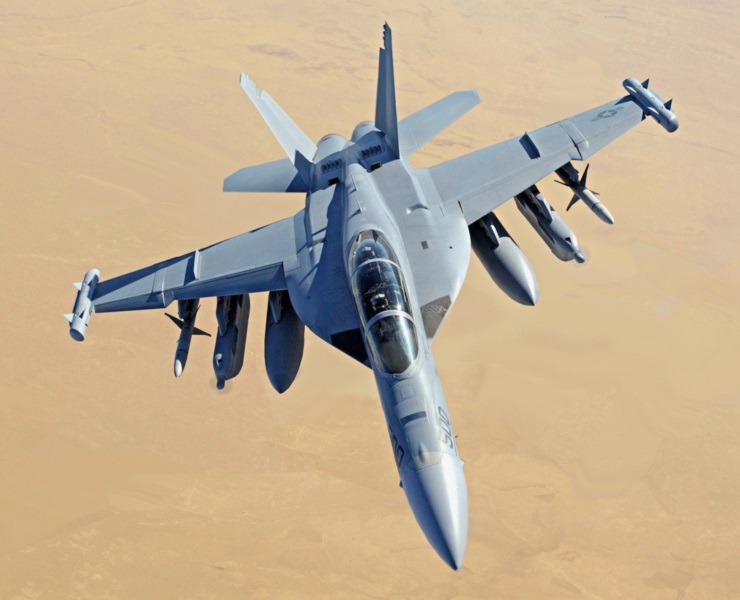
The Growler's internal electronics warfare systems are being updated as well, but the real focus is on adding much more processing power to drive artificial intelligence software to support "Reactive Electronic Attack Measures (REAM)" -- in which the countermeasures system senses an adversary emitter, assesses it, and then automatically generates the appropriate countermeasures response, using software-reconfigurable hardware. This is particularly challenging with "frequency-agile" emitters that change their signal output unpredictably to make them harder to detect and spoof. It is expected that Block II updates will be delivered from 2025.
BACK_TO_TOP* The first foreign sale for the Super Hornet was a buy of 24 machines by Australia in 2007, with initial deliveries taking place in the spring of 2010 and final delivery in late 2011. Australia, as mentioned, was a legacy Hornet operator, and with the retirement of Australia's General Dynamics F-111 strike aircraft, there was a need to acquire a replacement long-range combat aircraft. The Super Bug didn't have the range of the F-111, but it had substantially more range than the legacy Hornet, and the Super Hornet's tanker capability could help it fill the range gap. Aussie Super Bugs quickly saw action, participating in strikes on Islamic State insurgents from 2014 -- being pulled out in late 2017, after Islamic State had been driven from Iraq.
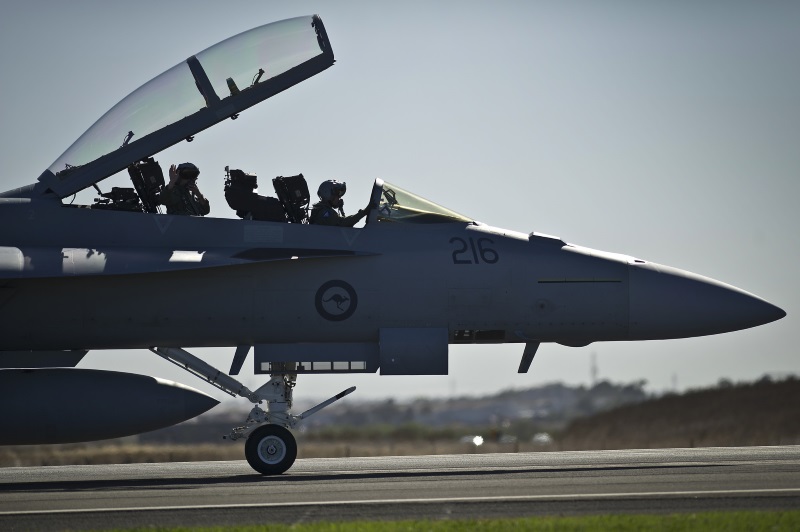
Although the Super Bug was obtained as an "interim solution" pending the later acquisition of the F-35 JSF, on evaluating the Super Hornet the Australians were extremely impressed with its capabilities, particularly the AN/APG-79 AESA and the ATFLIR pod. 12 Aussie Super Bugs were wired to be fitted up to Growler Lite ECM configuration, with the Australians committing to that upgrade in 2012 -- though the upgrade was canceled the next year, the Aussies preferring to buy a dozen new-build Growlers instead, carrying the AN/ALQ-99 jammer pod.
The first Aussie Growler was rolled out in 2015, with the last delivered in 2017, and introduction to service in 2019. One was lost in a mishap, to be replaced. The Australian EA-18G was much the same as US Navy Growlers, but was qualified for the AIM-9X AAM and the ATFLIR pod. The Australians, having a much smaller air fleet, wanted the AIM-9X so the Growler could protect itself, and wanted ATFLIR to validate targets picked up Growler RF targeting systems. Incidentally, since the Australians had never operated dedicated combat jamming aircraft before, operators ended up going through the US Navy curriculum to get up to speed.
The next buyer was Kuwait, which ordered 28 Super Hornets in 2018 -- 22 single-seaters and 6 two-seaters -- to replace its legacy Hornet fleet. The Kuwaitis obtained the Lockheed Martin Sniper pod for their Super Bugs, which were delivered in 2020:2021. They may well be the last export buyers, since the Super Hornet has lost other competitions, primarily to the F-35.
* In early 2011, Boeing displayed a full-sized mockup of a next-generation F/A-18E, with the "Advanced Super Hornet" featuring:
The Advanced Super Hornet concept retained the latest avionics from current production, particularly the AN/APG-79 AESA, but featured improvements such as enhanced stealth, as well as:
There was also a push to reduce cost by a substantial percentage to help international sales. Boeing and Northrop Grumman began flights of a demonstrator in 2013 featuring conformal fuel tanks, the weapons pod, and other refinements.
While Boeing was initially careful not to target the US Navy with the Advanced Super Hornet, it seems to avoid confrontation with the F-35 program, the Navy remained in the loop on the effort, suggesting refinements that Boeing added to the concept. The result was the "Block III" Super Hornet, with the Navy committing to the effort in mid-2017.
The Block III was much like the Advanced Super Hornet, but with less effort on stealth, limited to coatings and airframe tweaks; plus addition of a souped-up processing system, the "Distributed Targeting Processor Network (DTPN)", coupled to a "Tactical Targeting Network Technology (TTNT)" datalink. The idea behind DTPN and TTNT was to couple combat platforms together -- including airborne early warning aircraft like the Northrop Grumman Hawkeye, and shipboard systems -- into a unified network. Pilots performing trials of DTPN / TTNT technology described the distributed sensor fusion of AESA radar, warning systems, and IRST as "eye watering", giving them a view of the battlespace much broader and more detailed than could be obtained in a single Super Hornet. Along a separate track, the Navy has been working towards replacement of the ATFLIR pod, with an updated version of the Litening AT pod seen as having the edge.
The CFTs and F414 EPE engine update were deferred, while the integrated IRST was dropped -- though an externally-carried long-range IRST was seen as a major component of the Block III. Stealth was discarded because it was felt to compromise warload, with the Block III seen as a "heavyweight" adjunct to the stealthy F-35, not a competitor to it. A Boeing official described how they would work together:
BEGIN_QUOTE:
You can have an F-35 in its very stealthy way doing a deep-strike mission with Super Hornet providing air superiority at that same range, or you can have Super Hornet carrying large standoff weapons that F-35 cannot carry, with F-35 providing some air cover,
END_QUOTE
Two Block III prototypes were produced in 2020, leading to initial production deliveries in 2021. The Navy had ordered 78 Block III machines in 2019, but the order was cut to 24 in 2020, in order to focus on a follow-on "Next-Generation Air Dominance (NGAD)" fighter. The final Super Hornets will be delivered in 2025.
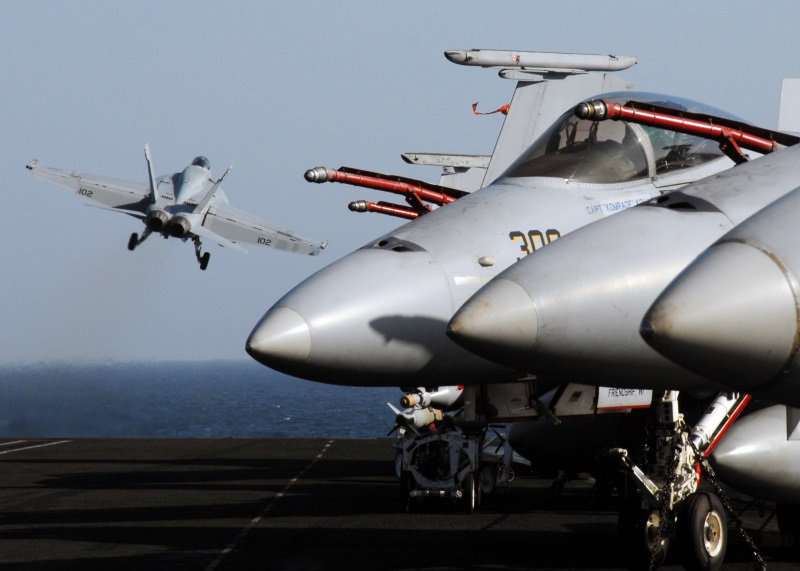
The oldest Super Hornets reached their 6,000-hour design lifetime in 2017; Boeing was then awarded a contract to perform a "service-life modification (SLM)" to extend their lifetimes to 7,500 hours, as well as improve the maintainability of the airframes. A next-stage upgrade is in progress to provide an airframe life of 10,000 hours, and bringing the aircraft up to Block III spec. New-production Block III Super Hornets are being built with a 10,000-hour service life. The Navy is planning to keep the Super Hornet in service at least into the 2040s, which suggests further upgrades of the type.
The Aussies have been upgrading their Super Bugs in parallel with the US Navy effort, being pro-active participants in the upgrades. The Aussies are planning to perform both the Block III Super Hornet and Block II Growler upgrades.
BACK_TO_TOP* The Hornet was the last one of the modern American first-line fighters I documented. I am sure that the type has its fans, but somehow it's never caught my imagination. A colleague told me it was "downright ugly"; I wouldn't be that blunt myself, but it certainly doesn't look like it would win any beauty prizes, having more than its fair share of angles and edges. I find it seems slightly "bent", some suggesting that somebody sat on it. I have yet to find pictures of the thing that seem particularly inspiring. However, I'm not a Hornet-basher. Although some sources are blunt in their criticisms of the type, it's not something I would lose much sleep over.
I need to add that, when I suggested to a Swiss penpal that the Hornet looked like it had been sat on, he replied: "Yes -- but you don't want to sit on a hornet!"
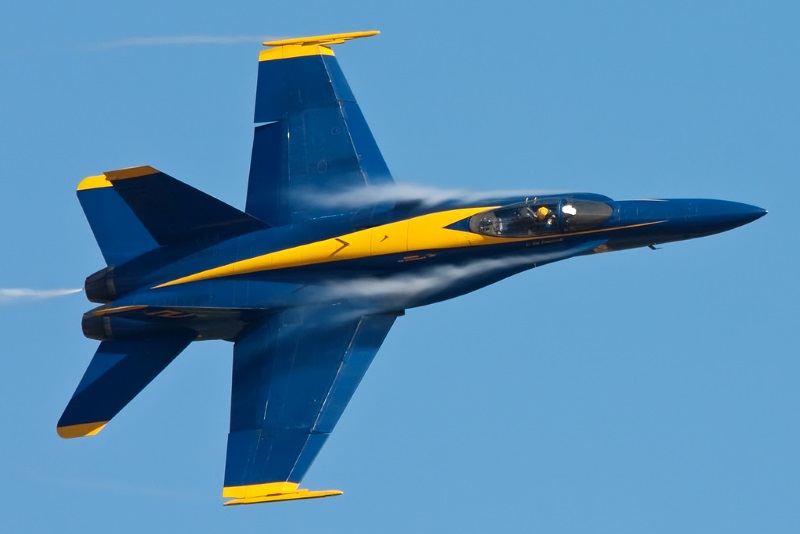
* Sources include:
* Illustrations details:
* Revision history:
v1.0.0 / 01 apr 04 v1.0.1 / 01 mar 06 / Review & polish. v1.0.2 / 01 apr 07 / Various additions of small details. v1.0.3 / 01 apr 09 / Additions of minor details. v1.0.4 / 01 may 10 / Review & polish. v1.0.5 / 01 mar 11 / Various small fixes. v1.0.6 / 01 feb 13 / Review & polish. v1.0.7 / 01 jun 14 / Review & polish. v1.1.0 / 01 may 16 / Review & polish. v1.2.0 / 01 apr 18 / Review & polish. v1.3.0 / 01 jul 20 / Considerable updates on Super Bug, new illustrations. v1.4.0 / 01 apr 22 / Review & polish.BACK_TO_TOP
